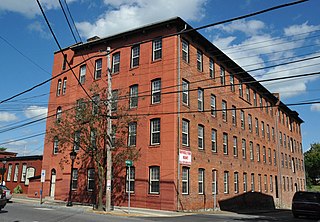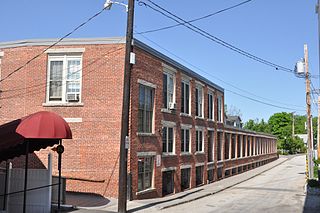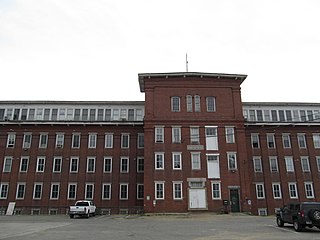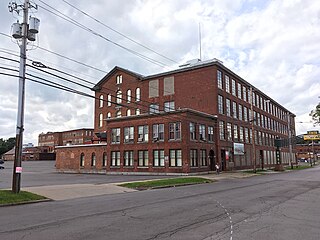
The Bates Mill is a textile factory company founded in 1850 and located at 35 Canal Street in Lewiston, Maine. The mill served as Maine's largest employer through the 1860s, and early profits from the mill provided much of the initial capital for nearby Bates College. Currently, the mill buildings are home to several new businesses, apartments, and a small museum.

The Bourne Mill is an historic textile mill on the border between Tiverton, Rhode Island and Fall River, Massachusetts.

The Hanora Mills are a historic textile mill complex the center of Woonsocket, Rhode Island.

The Bigelow Carpet Company Woolen Mills are a historic mill complex on Main Street in Clinton, Massachusetts. The sprawling mill complex was built or expanded by the Bigelow Carpet Company, one of Clinton's leading business for much of the 19th and early 20th centuries. The complex was listed on the National Register of Historic Places in 1983. It continues to be adaptivelry reused by smaller businesses.

The Central Village Historic District is a historic district in the Central Village area of Plainfield, Connecticut that was listed on the National Register of Historic Places (NRHP) in 1991. It encompasses a late 19th-century historic mill village, including a small commercial center where Connecticut Route 12 and 14 meet, a cluster of architecturally distinguished buildings built by mill owners and managers, and a collection of mill worker housing units. It includes the Plainfield Woolen Company Mill, which is separately listed, as well as archaeological remnants of other mill infrastructure. It also includes Plainfield's old town hall and high school. Other architecturally prominent buildings include the c. 1855 Italianate mansion of mill owner Arthur Fenner, and the 1845 Greek Revival Congregational Church.

The North Canal Historic District of Lawrence, Massachusetts, encompasses the historic industrial heart of the city. It is centered on the North Canal and the Great Stone Dam, which provided the waterpower for its many mill complexes. The canal was listed on the National Register of Historic Places in 1975, while the district was first listed in 1984, and then expanded slightly in 2009.

The Hamilton Woolen Company Historic District encompasses the well preserved "Big Mill" complex of the Hamilton Woolen Company, built in the mid 19th century. Located at the confluence of McKinstry Brook and the Quinebaug River in central Southbridge, Massachusetts, the complex consists of a cluster of mill buildings and a rare collection of 1830s brick mill worker housing units located nearby. The district was listed on the National Register of Historic Places in 1989.
Stuyvesant Falls Mill District is a national historic district located in the town of Stuyvesant in Columbia County, New York. The district includes six contributing buildings, five contributing sites, and two contributing structures. They are the industrial sites and power sources from which the adjoining village of Stuyvesant Falls derived its livelihood. It includes the Upper and Lower Falls and mill dams; on the east bank of Kinderhook Creek the sites of a grist mill and paper mill, cotton mill, woolen mill complex and extant hydroelectric plant; west bank operations including three extant 19th century cotton mills and several dwellings. Also included is an iron truss bridge erected in 1899.

Minterburn Mill is a former textile mill complex located at 215 East Main Street, in the Rockville village of Vernon, Connecticut. Developed beginning in 1834, it was the first place in Rockville to be developed industrially, and the surviving buildings provide a view of evolutionary changes in mill architecture. The mill was listed on the National Register of Historic Places in 1984. It was converted into an apartment complex in 2016 by the state.

The Crosley–Garrett Mill Workers' Housing, Store, and Mill Site, also known as Paper Mill House and the William Crosley Store and Mill Workers' House, is a historic mill-related complex located on Darby Creek in Newtown Township, Delaware County, Pennsylvania. The complex consists of a four-family stone Workers' Housing unit (1828), with an attached store (1845), and the archaeological remains of William Crosley's Woolen Mill (1828-1861) and Casper S. Garrett's Union Paper Mill (1869-1889).

Kitson Woolen Mill, also known as the Holland Thread Company building, is a historic woolen mill complex located at Stroudsburg, Monroe County, Pennsylvania. The complex consists of four brick buildings built between 1893 and 1904. They are arranged in a "U"-shape and consist of the "East Wing," "West Wing," boiler house, and office. The Kitson Woolen Mill was in operation until 1928, after which the mill was occupied by the Holland Thread Company until 1978.

The Winooski Falls Mill District is located along the Winooski River in the cities of Winooski and Burlington, Vermont, in the United States of America. It encompasses a major industrial area that developed around two sets of falls on the river in the 19th century.

Washington Avenue Historic District, or Washington Avenue Factory District, is a national historic district located in the Hawthorne and Bella Vista neighborhoods of South Philadelphia, Pennsylvania. It comprises the remaining four blocks of one of the last industrial neighborhoods in Philadelphia, and encompasses eight contributing buildings built between 1889 and 1927:

Charlestown Village Historic District is a national historic district located in Charlestown Township, Chester County, Pennsylvania. It is adjacent to the Middle Pickering Rural Historic District. It encompasses 21 contributing buildings and 1 contributing structure on 7 properties in the crossroads village of Charlestown. They date between about 1740 and 1870, and are reflective of a number of popular architectural styles including Late Victorian and Italianate. The oldest is the Job Harvey House, built about 1740. Also included is the Charlestown Woolen Mill (1862-1865), William Nixon House, Charlestown Methodist Episcopal Church, Moses King House, William Howard house and wheelwright shop, and the "Town Hall."

West Vincent Highlands Historic District is a national historic district located in Upper Uwchlan Township and West Vincent Township, Chester County, Pennsylvania. The district includes 147 contributing buildings, 7 contributing sites, and 6 contributing structures in a rural area of Chester County. It includes a variety of early- to mid-19th century vernacular farmhouses and related outbuildings. Other buildings include a stone grist mill (1808) and woolen mill (1813).

The Milford Cotton and Woolen Manufacturing Company is a historic mill complex at 2 Bridge Street in the center of Milford, New Hampshire. Developed between 1813 and World War I, it is one of the few surviving mill complexes in Milford, whose name is derived in part from "mill". The buildings were listed on the National Register of Historic Places in 1982. The complex has been converted into residential use.

The Salmon Falls Mill Historic District encompasses a historic mill complex on Front Street in Rollinsford, New Hampshire. The complex includes four major structures and seven smaller ones, on about 14 acres (5.7 ha) of land along the Salmon Falls River. They were built between about 1840 and the mid-1860s, and have an unusual architectural unity, for additions made to the buildings were done with attention to matching design elements from the existing structures. The Number 2 Mill, built in 1848, was an early location where a turbine was used instead of a waterwheel to provide power to the mill machinery. The district was listed on the National Register of Historic Places in 1980.

Spray Industrial Historic District is a national historic district located at Eden, Rockingham County, North Carolina. It encompasses 70 contributing buildings, 9 contributing structures, and 1 contributing object in an industrial section of the town of Eden. It includes buildings associated with eight textile mill complexes, mill village housing, and seven commercial buildings. Notable contributing resources include the Smith River Dam and Spray Power canal, Morehead Cotton Mill complex, "Superintendent's" House, Imperial Bank and Trust Company (1912), Leaksville Cotton Mills complex, Spray Mercantile Building, Spray Cotton Mills complex, Lily Mill complex, Nantucket Mills complex designed by R. C. Biberstein, American Warehouse Company complex, Rhode Island Mill complex, Phillips-Chatham House, and Spray Woolen Mill complex.

Globe Woolen Company Mills is a historic woolen mill complex and national historic district located at Utica, Oneida County, New York. It encompasses four contributing components of an intact mill complex: the Woolen Mill Grouping (1872-1873); Storehouse #2 (1872-1873); Storehouse #3 (1872-1873); and the Worsted Mill Grouping (1886). They include four-story mill buildings, attached company office, and two remaining store houses. The buildings are constructed of red brick and have Italianate style design elements. After the mill closed in the 1950s, the buildings were reused for college classrooms and later as offices.

The Winthrop Mills Company is a historic textile mill complex at 149-151 Main Street in Winthrop, Maine. Developed mainly between the late 19th and mid-20th centuries, it was the nation's largest manufacturer of woolen blankets for many years, and a major local employer for about 150 years. It was listed on the National Register of Historic Places in 2014.























